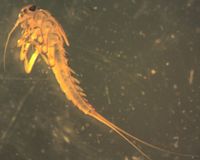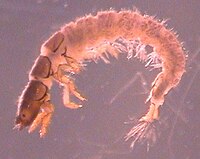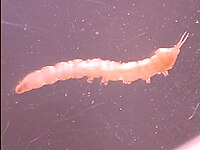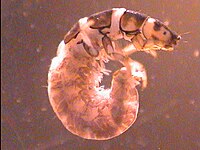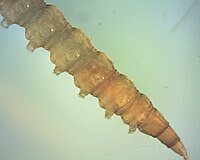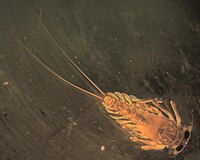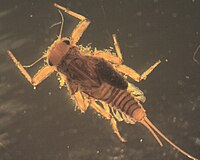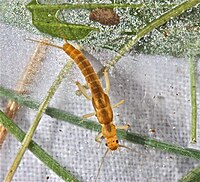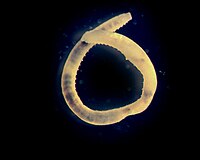Shady Rill
From WikiEducator
The following are the most common invertebrates collected from this stream site.
Contents
Baetis
- Order
- Ephemeroptera
- Family
- Baetidae
- Genus
- Baetis
- Common name
- The Little Olive
- Tied fly
- Sawyer Pheasant Tail Nymph
This mayfly has three "tails" and a unique head shape. Its gills are oval shaped and insert dorsally. More mature nymphs have long, dark wing pads.
Image of the long, dark wing pads.
Cheumatopsyche
Cheumatopsyche has a forked foretrochantin (as does Ceratopsyche). The foretrochantin is the projection at the uppermost portion of the front leg closest to the head. The leg may need to be pulled away from the body to expose this feature. Cheumatopsyche have a small or inconspicuous pair of sclerites under the prosternal plate that are difficult to see. Contrast that with the larger pair of sclerites found on Ceratopsyche. To access sclerites, it's best to gently pull the pronotum and mesonotum in opposite directions. Note: the large single sclerite is the prosternal plate. Cheumatopsyche have only 2 types of hair on the abdomen: long thin plain hairs and thicker club hairs, which are narrow close to the body and widen out at the distal end. Paired sclerites on the ninth abdominal segment are notched.
Dicranota
Dicranota can be distinguished by the two tails and their comb feet. There are usually 5 pairs of prolegs on the abdomen with combs on them. In addition, the posterior portion of the abdomen often has a slight swelling.
Image of the prolegs.
Ceratopsyche
Ceratopsyche has a forked foretrochantin. The foretrochantin is the projection at the uppermost portion of the foreleg. The leg may need to be pulled away from the body to expose this feature. Ceratopsyche have a large pair of sclerites underneath the prosternum. Note: the large single sclerite is the prosternal plate. Biologists have gone back and forth between lumping this genus into Hydropsyche and splitting it back out. ITIS currently lists it as a genus (Feb 2013) but we are aware of a recent paper that lumped it under Hydropsyche.
Arctopsyche
Caddisfly larvae from the genus Arctopsyche have a single long seta (hair) on segments above the gills, in sa2 and sa3 positions, as opposed to tufts. The ventral apotome, viewed on the underside of the head, narrows posteriorly.
Images of the single long seta in the sa2 and sa3 positions.
Pedicia
Creeping welts or broad tubercles are found on this Tipulidae. No spiracles are present, but the surface may appear roughened under the microscope.
Images of the creeping welts, seemingly roughened exterior, a tail view, and ventral view.
Epeorus
- Order
- Ephemeroptera
- Family
- Heptageniidae
- Genus
- Epeorus
- Common name
- The Quill Gordon
- Tied fly
- Quill Gordon
This is the only Heptageniidae genus present in this area with two tails!
Siphlonuridae
- Order
- Ephemeroptera
- Family
- Siphlonuridae
- Genus
- Siphlonurus
- Common name
- The Gray Drake
- Tied fly
- Gold-ribbed Hare's Ear
This family has gills on all abdominal segments. The labrum does not have a deep notch, and maxillae do not have pectinate spines. They have posterolateral spines on their last abdominal segment.
Click to view the spines on the last abdominal segment, unlike those found in Baetidae.
Leuctra
This family of stonefly is fairly slender by stonefly standards. The divergent wing pads are a helpful characteristic. Leuctridae are similar in overall shape to the Capniidae; however, Leuctridae often do not have pleural folds. If they are present, they only extend from abdominal segments 1-7. Leuctra are recognized by abdominal terga with posterior fringes of short hairs and last few segments with longer hairs.
Image of the divergent wing pads.
Oligochaeta
Aquatic earthworms lack legs and are characterized by having 20 or more segments. Unlike leeches, they lack a suction disk. We collect members of two or more orders in this class as small numbers of stream sites and they are rarely numerous. They are more common at pond and lake sites.
Image of the 20 or more segments.

